This season will mark Nottingham Forest’s second consecutive season in the Premier League, following a long absence from the top flight starting in the 1998/99 season.
The Garibaldi finished last season with 38 points, four away from relegation, despite signing about 30 new players since their promotion in an attempt to rebuild the team.
Unfortunately, the squad did not look as solid as required last season, and the performances could have been more convincing. Remaining in the Premier League does not hide the fact that The Reds will have to work much better in terms of signings and improve the team’s performances by making urgent tactical changes to find the most suitable formation and line-ups ahead of the season.
It will also be necessary to improve their statistics to help them perform better from an attacking and defensive perspective since they failed to win when they were favourites and rarely made positive surprises when facing tough opponents, suffering quite a few heavy losses.
At the same time, some performances and results are worth looking back at as motivation to build upon this season, such as the 1-0 win against Liverpool, the 2-0 win against Tottenham in the EFL Cup, the 1-1 and 2-2 draws against Chelsea, the 1-1 draw against Manchester City and the 1-0 win against Arsenal.
These positive results show that Nottingham Forest are not bad, and they don’t lack good players. They need consistency, the ability to keep the same level of performance for consecutive fixtures, and the mastery of adaptability to different kinds of opponents.
This tactical analysis scout report will aim at presenting the key strengths and weaknesses of this team, providing an analysis on their attacking and defensive tactics, as well as looking at their key players and predicting their 2023/24 seasonal results.
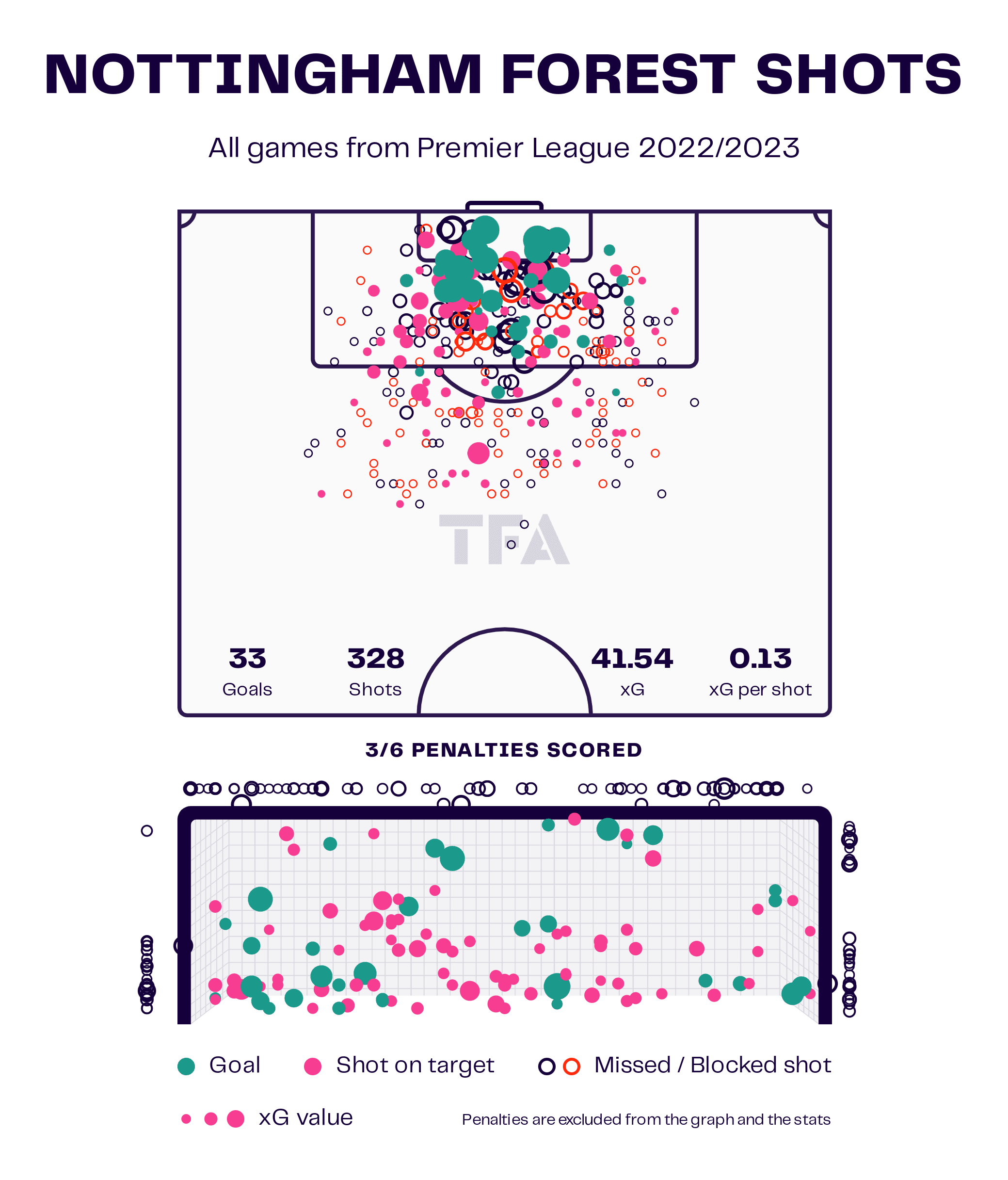
Nottingham Forest scored 33 non-penalty goals last season from an xG of 41.54. Their chance creation perhaps deserved an extra couple of goals than reality delivered, so improving their number of goals compared to their xG would help them achieve a higher place this season in the final standings.
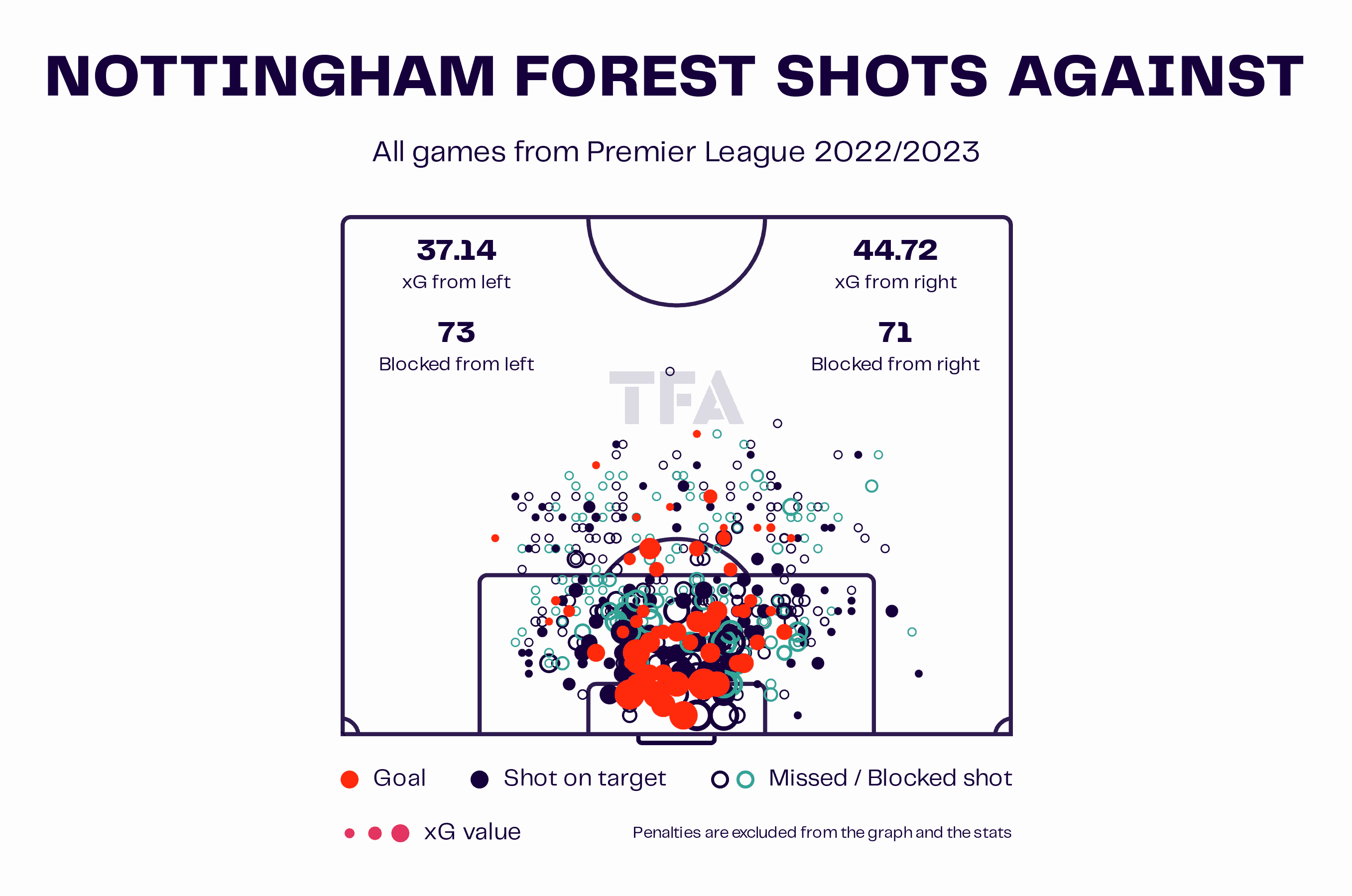
Meanwhile, it’s clear that Forest need to reduce the number of chances they’ve been conceding to stand a hope of avoiding a relegation fight this season, as their xGA numbers from last term don’t make for pretty reading.
Despite being incredibly active during the 2022/2023 transfer windows and changing a large part of the squad, Nottingham Forest are in need to make some transfer activity this summer to reinforce the team in critical areas further to challenge for a higher spot than last season and avoid the late relegation battle.
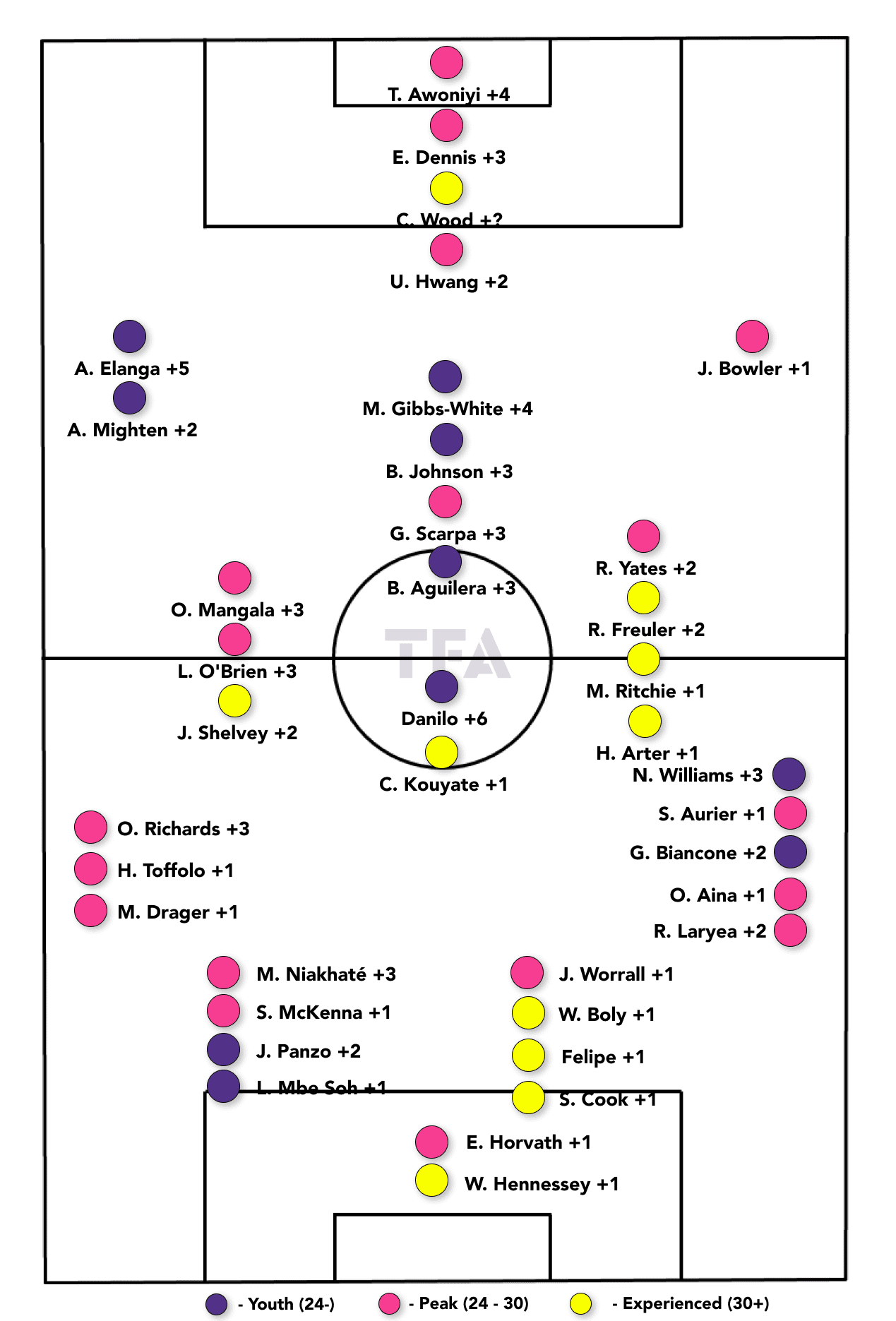
The Reds just signed right-back Ola Aina a few days ago, and this means that two or three of the many right-backs (Giulian Bianconi, Richie Laryea, Mohamed Dräger, Ola Aina, Neco Williams and Serge Aurier) will be out on loan or on the transfer list very soon.
At the same time, most other areas are already filled with good players, especially the attacking area, where the team now has Chris Wood, Ui-jo Hwang, Sam Surridge, Emmanuel Dennis and Taiwo Awoniyi.
Nevertheless, the management will have to think about finding some suitable wingers for the team since only Josh Bowler and Alex Mighten can occupy the right and left wingers’ spots, with no back-ups nor upgrades in these two positions. Last season, Cooper struggled to put on powerful attacking performances — partly due to not having key wingers and therefore resorting to various formations that don’t rely on wingers but instead on wing-backs or midfielders such as the 5-4-1, the 3-4-2-1, the 4-3-2-1 and more.
One of the most impressive yet complicated signings to strive for regarding the right-winger position would be to attempt going for Bournemouth’s Dango Ouattara, who has shown great signs since his transfer in the winter transfer window.
If negotiations for Ouattara prove unsuccessful, Badredine Bouanani would be a promising alternative who can guarantee outstanding quality on the right-wing thanks to his excellent ball control, pace, dribbling abilities and vision.
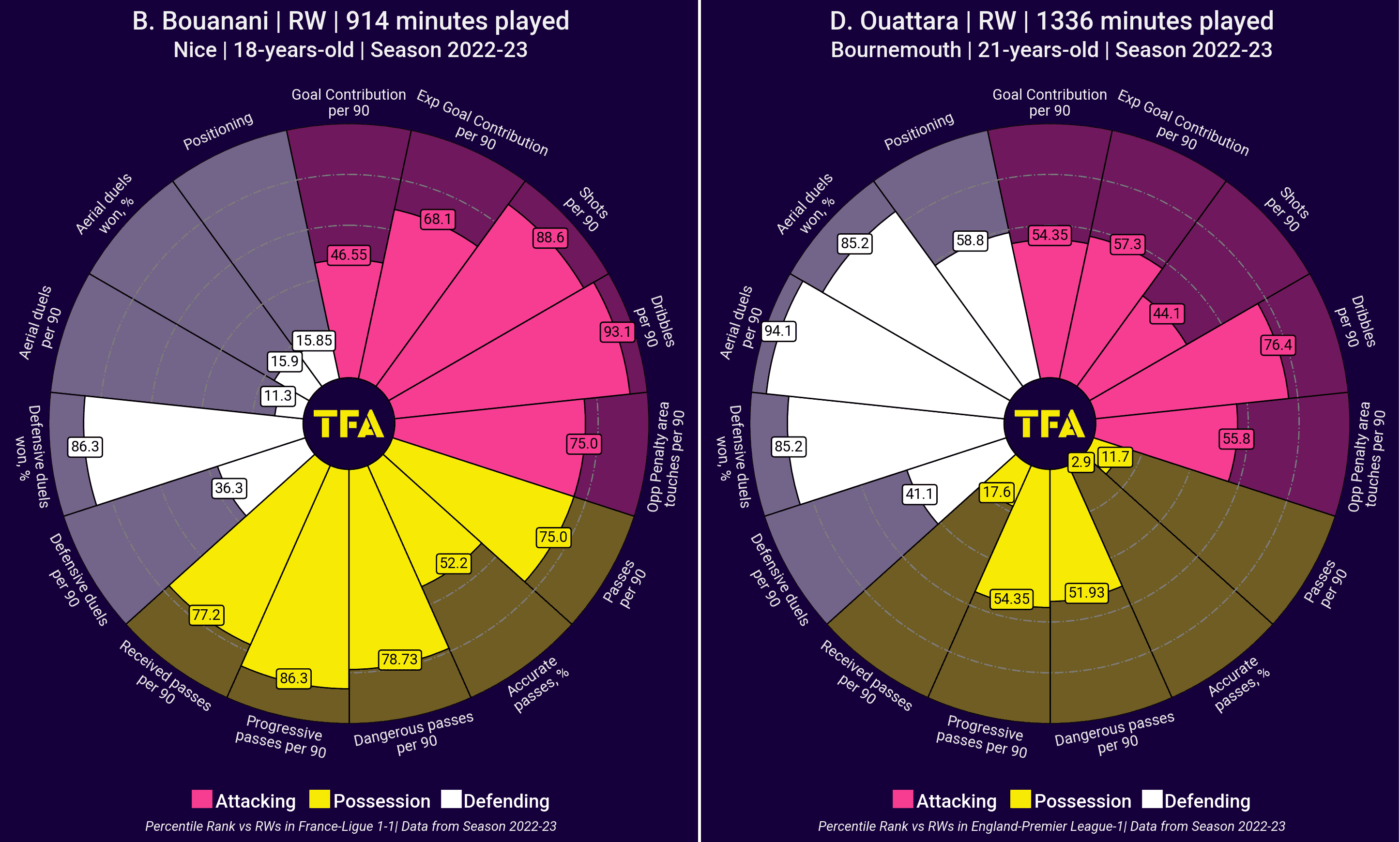
AGE PROFILE IMAGE
Selim-Ben-Hmida-5
Attacking Phase
Nottingham Forest’s attacking phase was characterised by some positives and negatives simultaneously. And although last season was not a positive one from an attacking perspective since the team failed to convince, there are some pleasing aspects that need to be worked on and reinforced for next season, in addition to fixing what was problematic.
The following graphic highlights Nottingham Forest’s crossing averages from the right and left wing. And although these averages are not worrying, it should be added that the absence of natural wingers and the reliance on attacking midfielders only reduces the average of successful crosses and therefore leaves Awoniyi, Wood, Hwang or just the playing main striker for next season with fewer chances to score with headers. And for strikers like Wood, for instance, crosses are fundamental because headers represent one of the player’s most valuable tools for finishing, given his 191cm height, and the same applies to Awoniyi and Hwang.
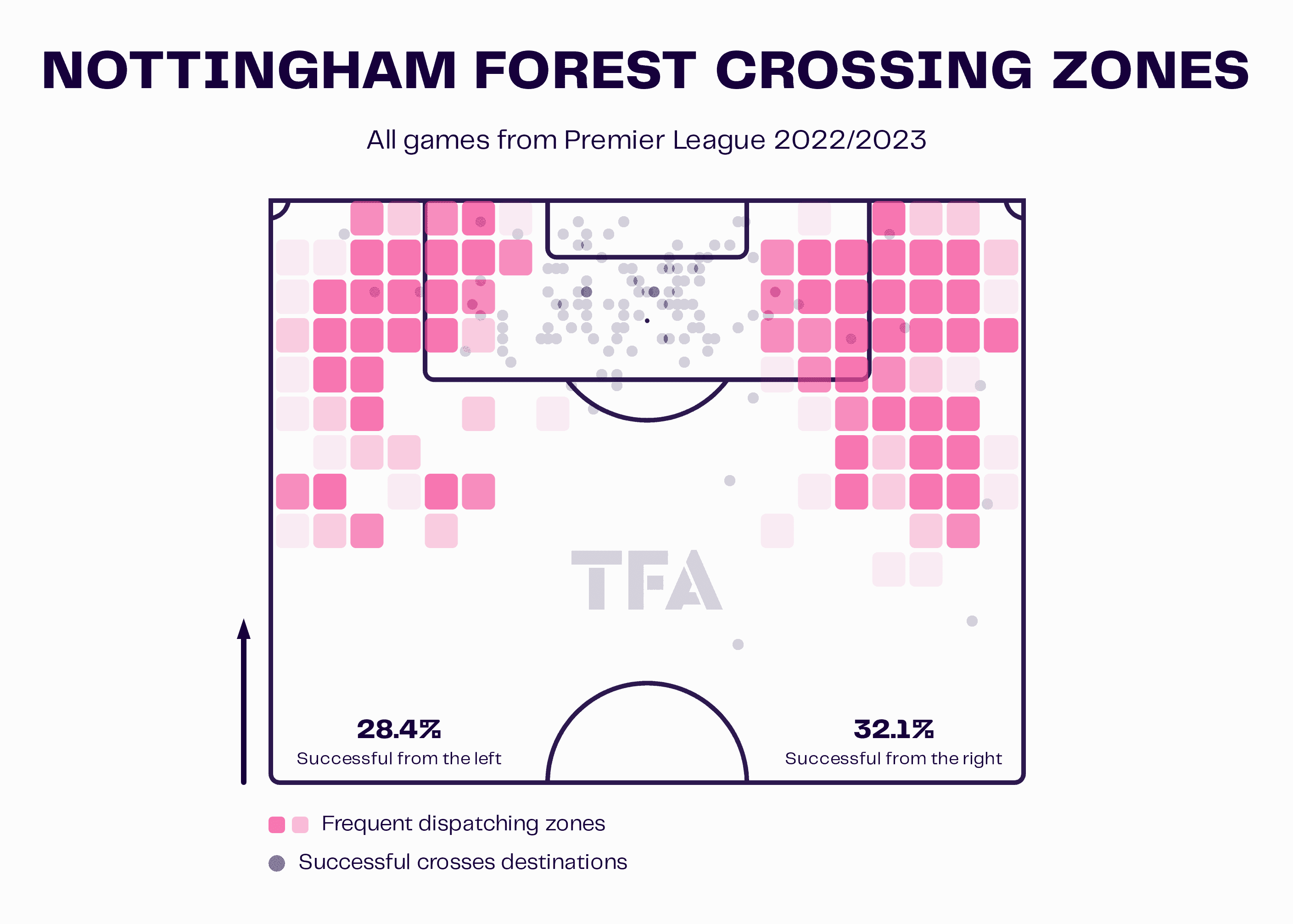
Nottingham Forest have significantly benefited from Morgan Gibbs-White’s excellent run of form in midfield and especially his incredible chemistry with Awoniyi in the attacking phase. Preserving and working on making this chemistry even more impactful will help the team greatly in chance creation and finishing.
The following image highlights this chemistry since it shows a goal that Awoniyi scored following an excellent assist from Gibbs-White with the exterior part of the foot after he saw Awoniyi moving towards the needed direction and prior to even noticing that Awoniyi was raising his hand to ask for a through pass.
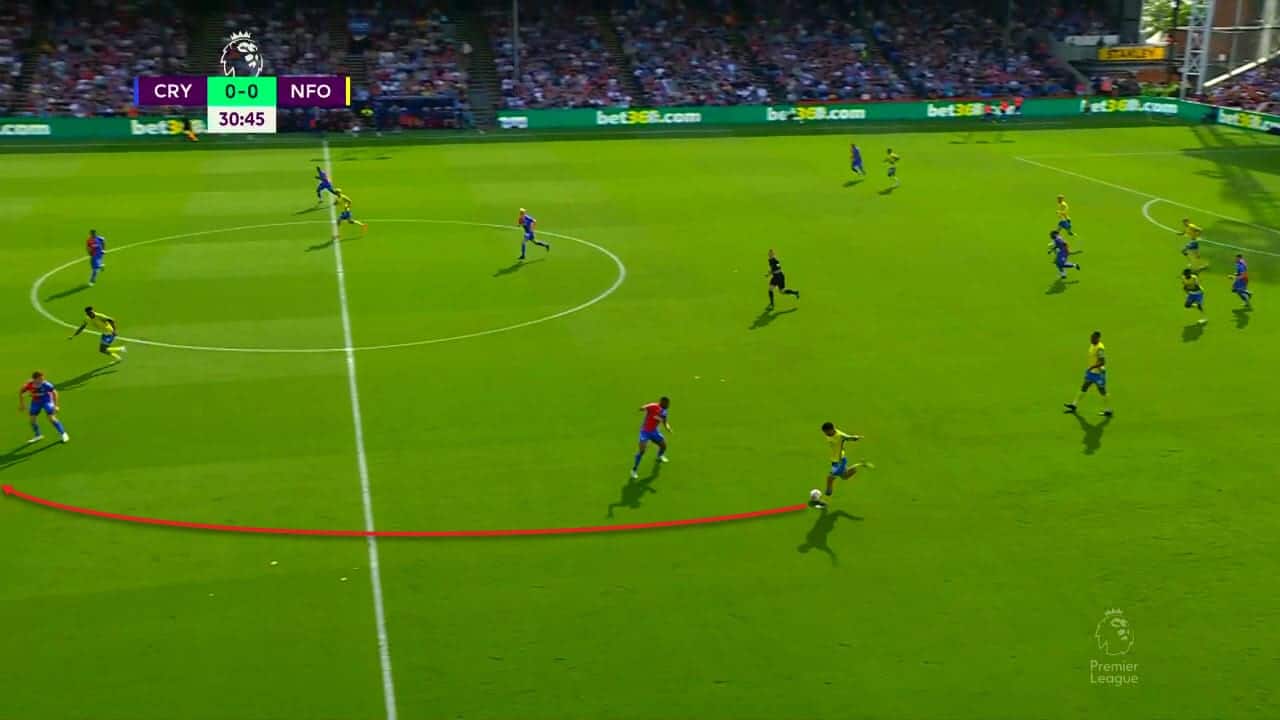
Moreover, Wood is a striker who showed last season that he knows precisely how to move without the ball, and his movements were usually calculated and valuable. His most notable action previous season was freeing himself from marking a few seconds before receiving a pass to score the equaliser against Manchester City. A striker with great physical skills and a constant reactivity to his surroundings would help the team find spaces upfront and create more dangerous actions. Wood and Awoniyi can make a powerful attacking duo if played together.
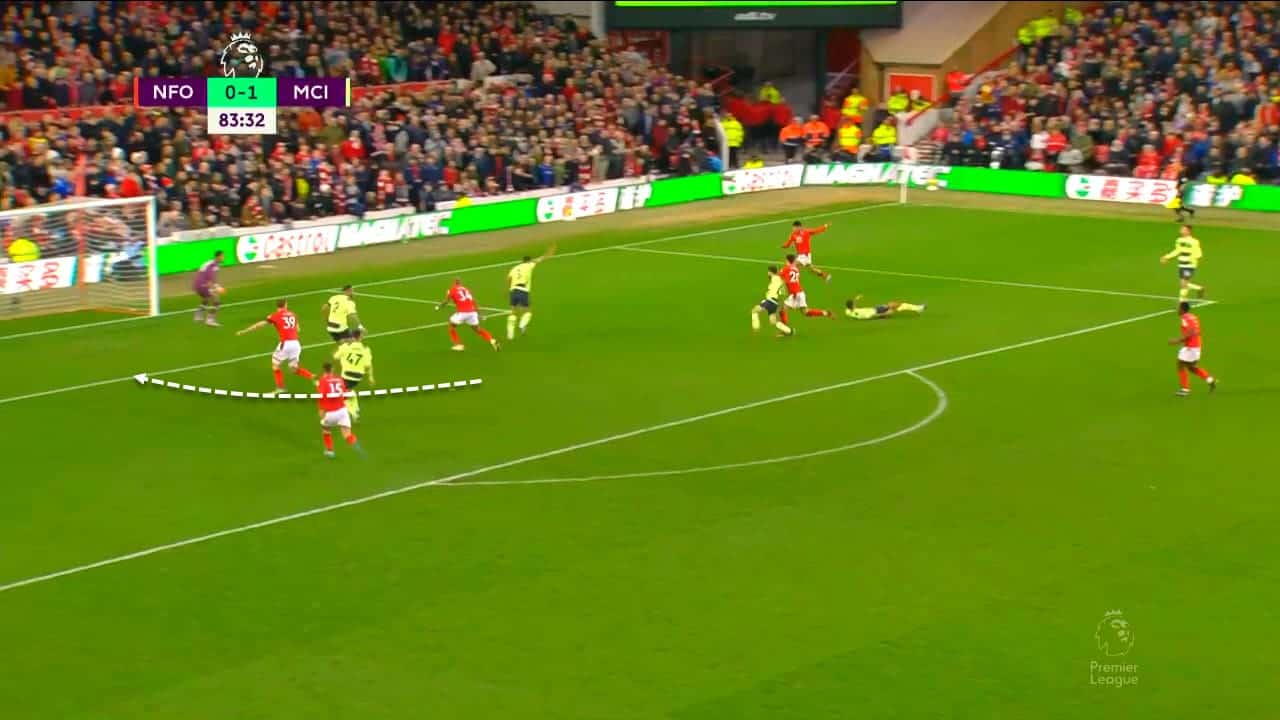
Another aspect that needs to be preserved and improved is set-piece efficiency and execution. Nottingham Forest were indeed able to score through set-pieces last season like they did in this example against Tottenham. Yet, Nottingham Forest can exploit this weapon even further by alternating their set-piece-taking ideas and training more specifically on finishing set-pieces following various schemes to succeed in surprising opponents rather than using the same one or two schemes.
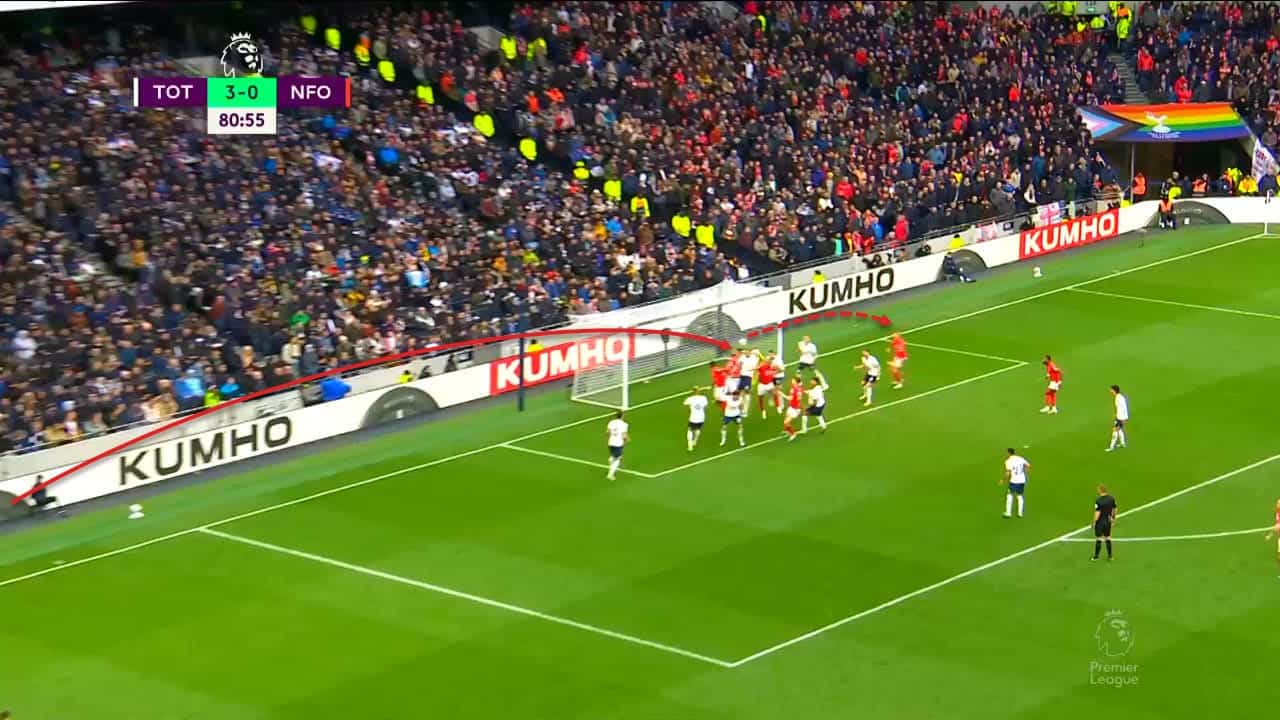
Defensive Phase
Nottingham Forest can be considered a defensive team par excellence because they usually play with numerous players at the back (sometimes five on the same defensive line), and they also prefer to opt for a very low defensive block, especially against powerful teams. Although this proved successful on certain occasions, it also led to losing considerably on some other occasions.
Therefore, relying on a very defensive system should be revised. Cooper must find the right balance between attack and defence without taking too many risks upfront or being super defensive without concrete motives.
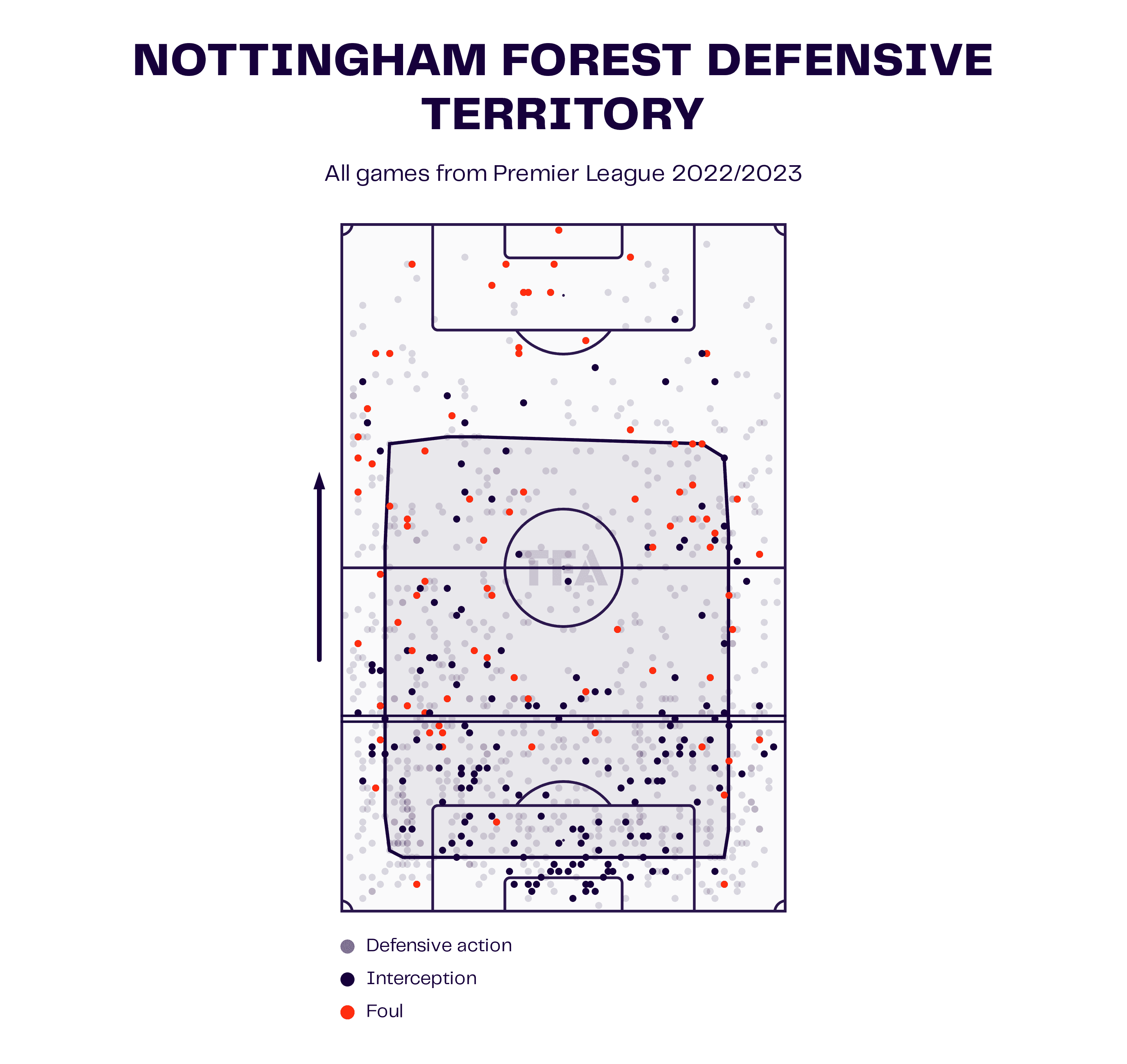
Moreover, the team will have to work a lot on individual marking, especially during set-pieces, because the Reds committed too many errors in this regard last season, which was one of the reasons that prevented them from not winning a higher number of points.
One of the most notable examples of this took place against Liverpool during a set-piece executed by Robertson and finished by Diogo Jota while the defender marking Jota (coloured in yellow) remained in his position and didn’t move at all when the free-kick was executed and especially when he saw Jota moving to meet the cross while being totally unmarked.
These types of mistakes should not take place at all at Nottingham Forest, and defenders should at least try to recover their marking errors by trying to disturb the player before reaching the ball.
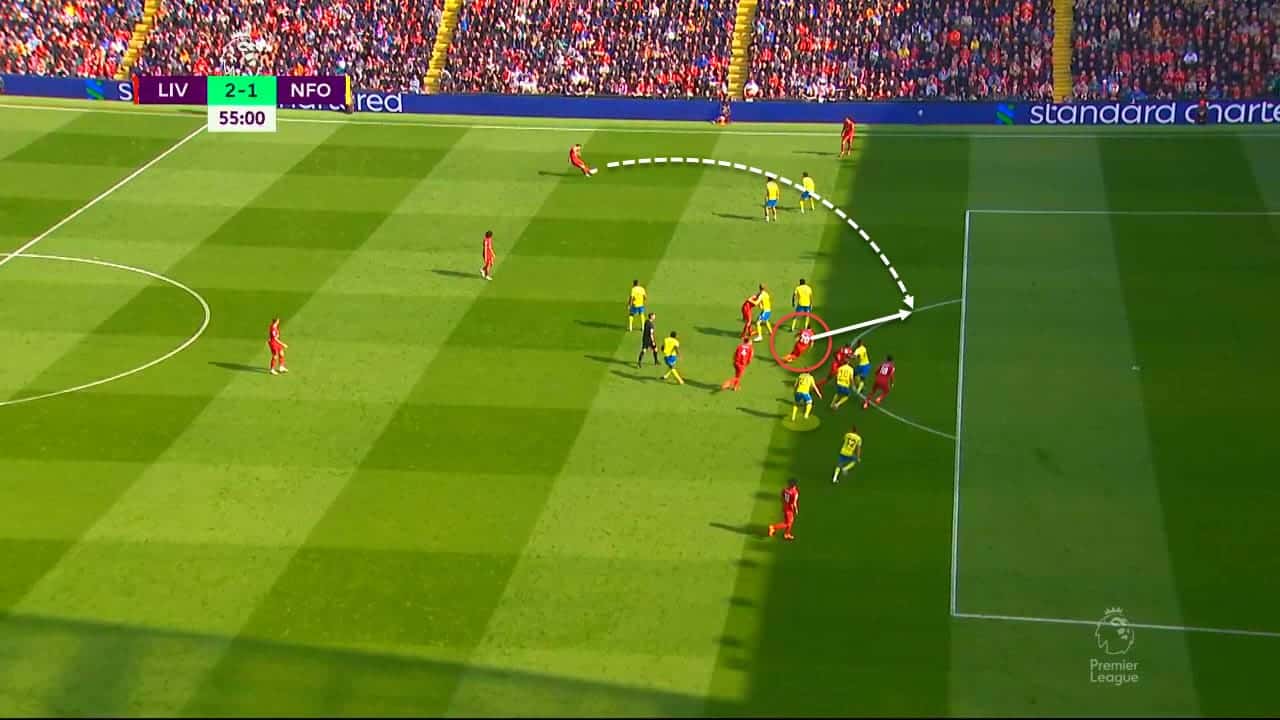
In fact, Nottingham Forest committed numerous marking mistakes from open play, too, against different teams. Even when they played with five defenders, such as against Chelsea, the marking errors led to conceding goals.
At the same time, the numerical superiority that Cooper imposed didn’t really help a lot. This means that working on marking and the defensive movements would benefit the team more than adding more players to the defensive line.
The following goal from Sterling was scored without him being disturbed or marked, mainly because Worrall didn’t look at Sterling and preferred to follow Loftus-Cheek, who was coming from behind but should have been marked by Felipe only.
At the same time, Serge Aurier didn’t attempt to cover for his teammate at all and didn’t move from his position to mark Sterling despite seeing that he was about to receive a pass in a dangerous area.
This passivity from Aurier and the confusion of centre-backs in knowing who should be marked by whom explains the defensive situation of the team and indicates that a lot of work is needed in terms of marking since the ideas still need to be clarified for these defenders.
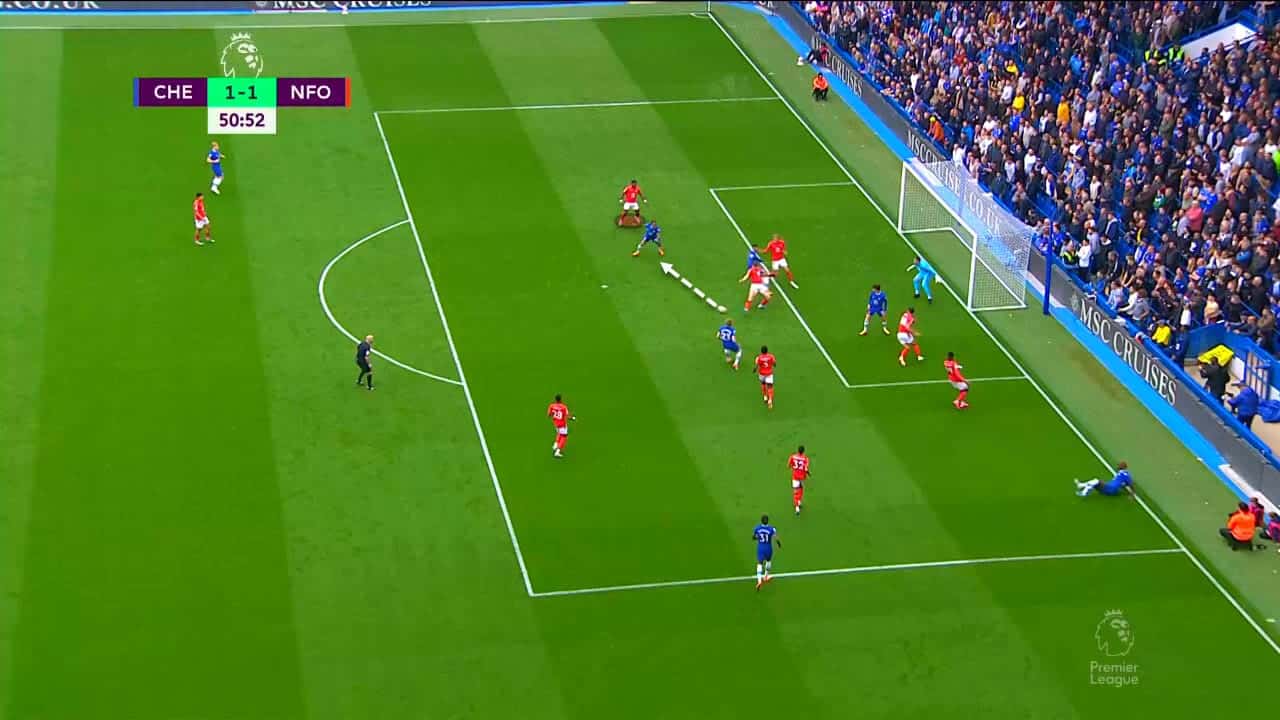
Transitions Phase
Regarding attacking transitions, Nottingham Forest proved on some occasions that they could be extremely dangerous after winning the ball since they have quick midfielders with good passing skills and strikers who can deal well when given space to attack.
Players like Remo Freuler and Gibbs-White can always be helpful in this regard, as they have the vision and the passing quality needed for launching key passes from distance to Awoniyi or other strikers.
In fact, Gibbs-White and Awoniyi succeeded on several occasions in transforming counter-attacks into goals, even when playing against organised teams like Arsenal. This picture shows one of Nottingham Forest’s best transitions and counter-attacks last season.
And the credit for this one goes to Gibbs-White, who ran with full speed as soon as he intercepted a pass in his team’s own half before reaching the final third very quickly to prevent Arsenal’s players from retreating in time. He also served Awoniyi with perfect timing, enabling him to score a goal without facing a lot of disturbance from Arsenal’s defence.

Concerning the defensive transitions, however, the team will need to avoid losing the ball in their own half as much as possible since these ball losses often lead to problems for Nottingham Forest since it doesn’t give much time for the defence to regroup and for midfielders to cover or retreat with the needed timing. It should be said that the team’s defence tends to quickly hold their positions when a player loses the ball in their half and do their best to avoid conceding a goal or leaving too much space for counter-attacks.
Yet, these defensive transitions are often dangerous for Nottingham Forest, even though most of the players try to retreat quickly when losing the ball.
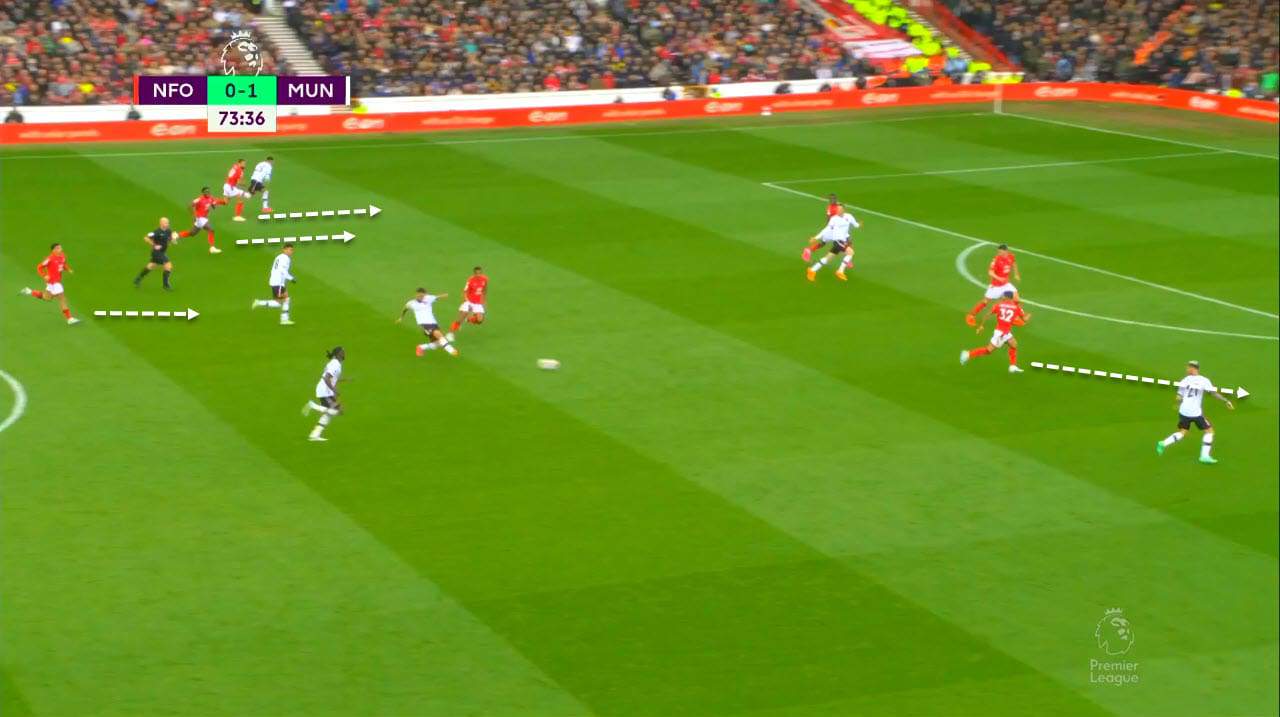
What can Cooper improve tactically?
Compared with last season, Cooper will have to make significant changes to improve the team’s performances from a defensive and attacking aspect. First, finding a more suitable formation for the team and filling the gaps existing in the team squad would be the priority since the team lacks quality wingers mainly at the moment.
Switching the formation to a more balanced one that relies on four defenders, two or three midfielders, wingers, and a striker or two would prove much more helpful for Nottingham Forest, mainly because the strikers will be much more supported if accompanied by wingers.
This would lead to being more dangerous in attack, primarily if the team relies a bit more on crossing and penetrations from the wings in addition to midfield penetrations from Gibbs-White, for instance. Therefore, the 4-3-3, the 4-4-2 or the 4-2-3-1 would be more beneficial for the Tricky Trees than the 5-4-1, the 3-4-2-1, the 4-3-2-1 etc.
In addition, improving the team’s possession rate will be essential next season if the team wants to win more games or even make more positive results than last season. Having only a 38.96% possession average last season meant that the team rarely imposed their playing style and usually defended while waiting for counter-attacking opportunities.
Although this can be useful on certain occasions, it shouldn’t be the team’s strategy for the whole season, as the team will need to impose their attacking plans and try to dominate when possible in order to score more goals and not just wait for counter-attacks or set-pieces.
Another aspect that needs to be fixed urgently is the need for more usage of wings. Nottingham Forest avoided using wingers last season, and even when they did, they played midfielders out of position and forced players with different characteristics than wingers to interpret the role, which simply didn’t work. Complicating things and trying to find complex solutions to problems that can be addressed more straightforwardly impacts the team negatively, as it appears that players were not really getting their head coach’s ideas very well last season.
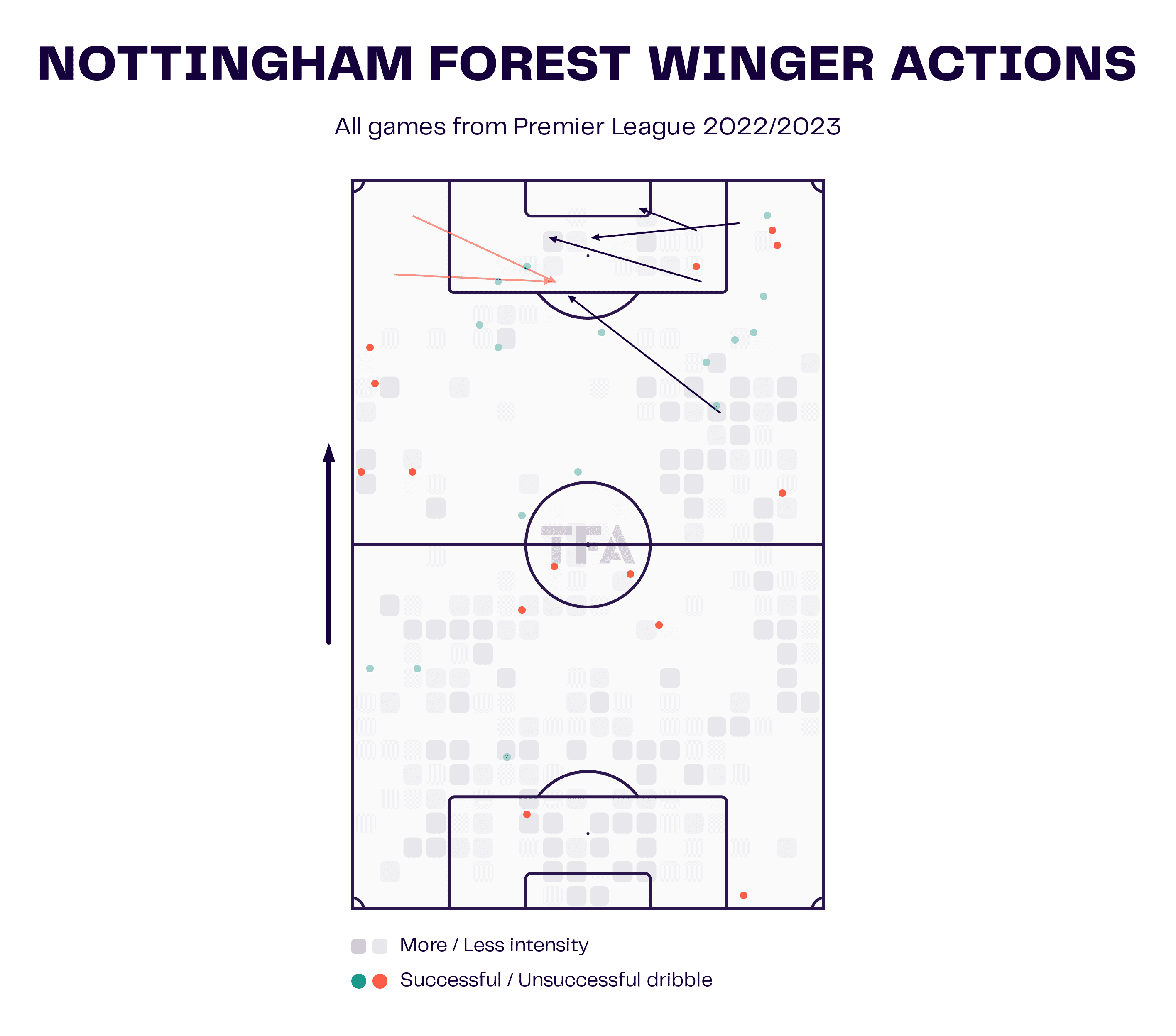
In order to be more solid as a team, a lot of work is needed on the defensive phase as well, especially in terms of marking and positioning inside the box. Nottingham Forest looked poor in this regard and needed more organisation in their own half, especially when facing powerful attacking teams.
If the club has the necessary resources, signing a new quality centre-back would prove very useful for the team as he would represent an upgrade and help reduce the number of defensive mistakes per game. Otherwise, working extensively on defensive positioning and marking in open play as well as during set-pieces, will be very important.
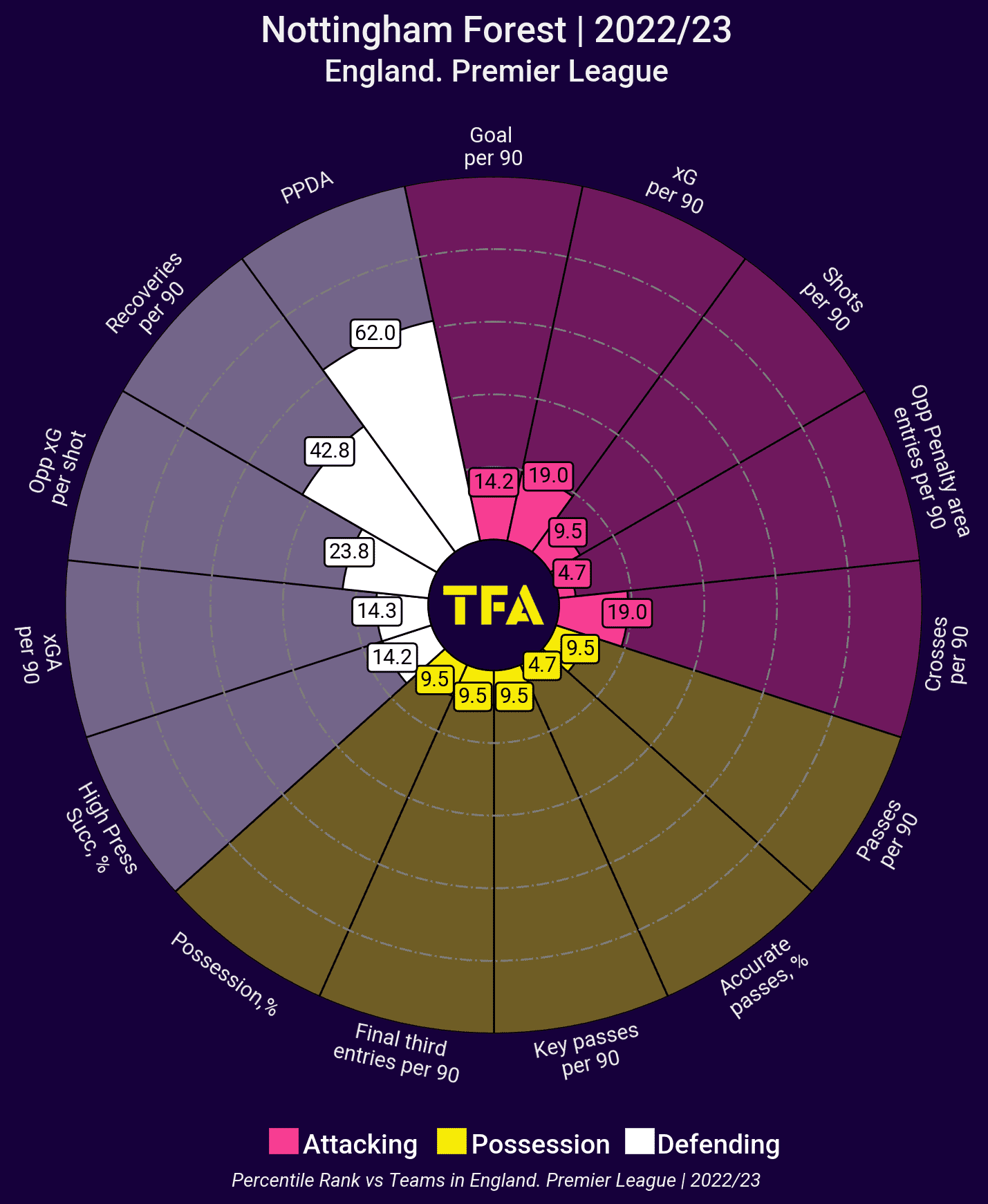
Key Player: Morgan Gibbs-White
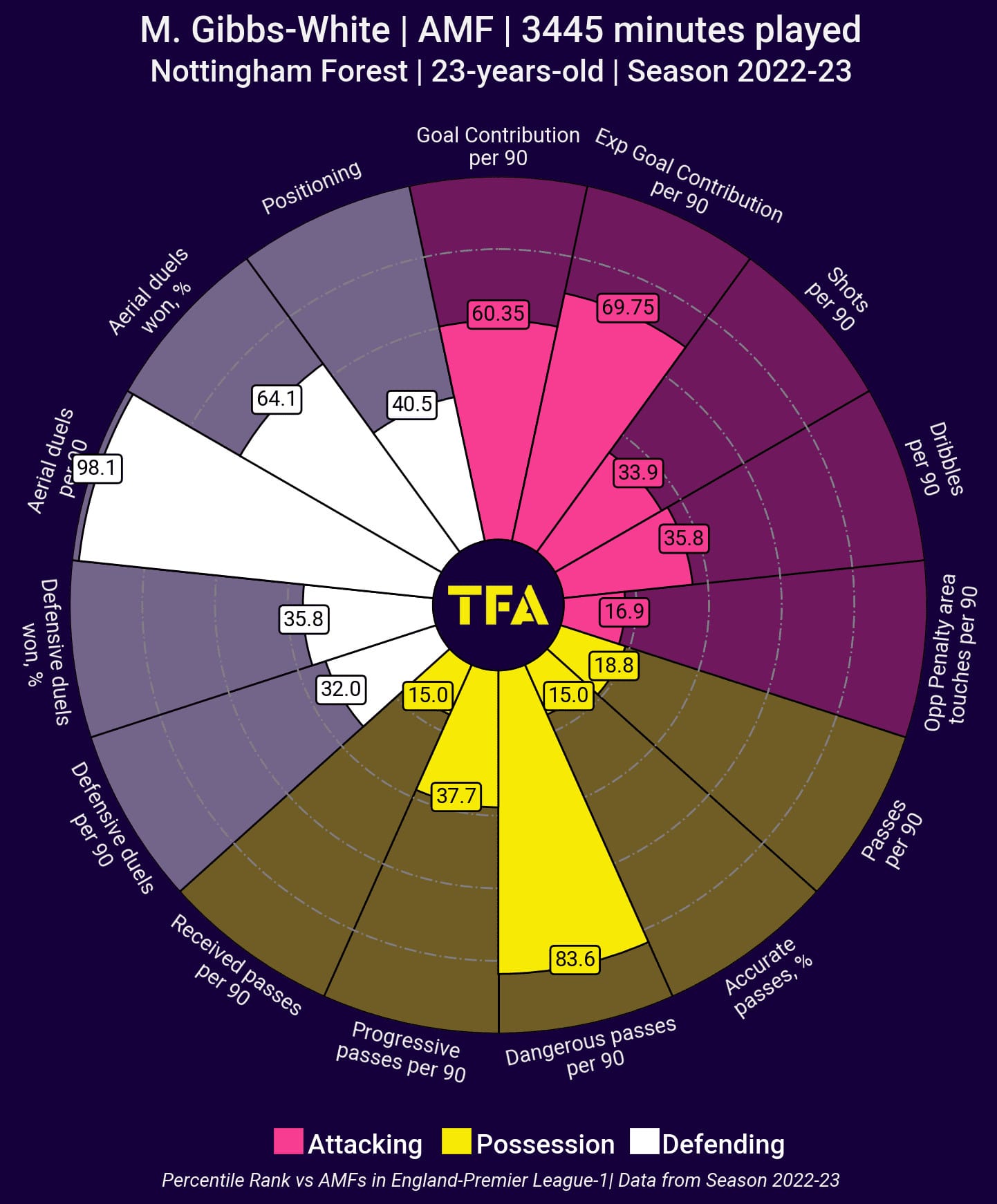
Gibbs-White has been a very impactful player for Nottingham Forest last season, if not the most impactful. As an attacking midfield, he played in various positions throughout the season and was effective even when he was positioned as a right-winger, left-winger, striker, and advanced playmaker. Gibbs-White’s most suitable position is the advanced playmaker one since it gives him the freedom to provide key passes and penetrate whenever needed using his excellent pace and dribbling skills.
The pizza graphic highlights his ability to consistently provide dangerous passes, especially in the final third, and confirms that he is usually impactful regarding goal contribution. Nevertheless, working more on his shooting averages, positioning, and defensive abilities would make him a more complete player.
One to Watch: Taiwo Awoniyi
Although Awoniyi scored some decisive goals in his first season with the Garibaldi, his second season could be much more successful as he will have had the time to settle in and know the team better than last season.
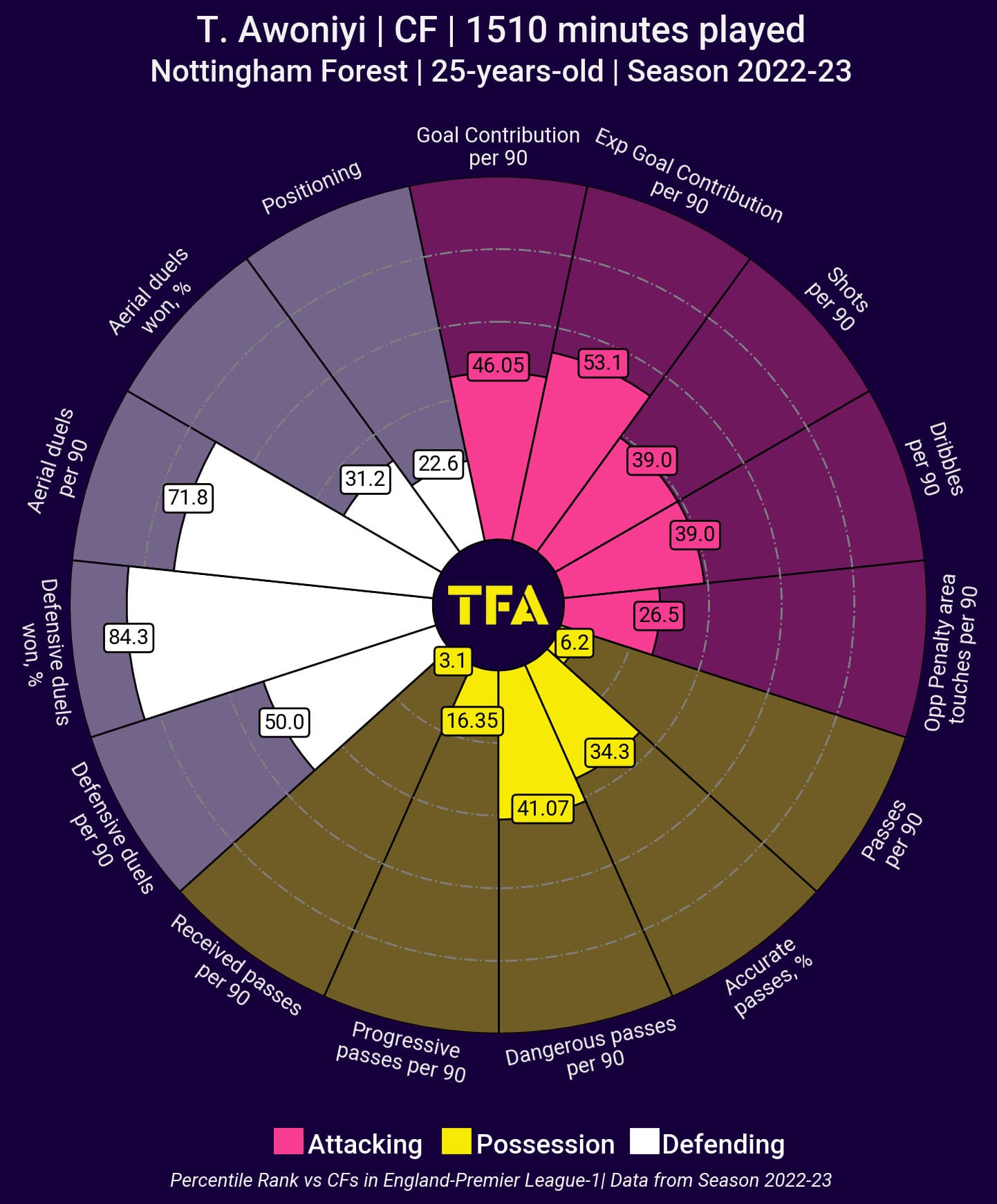
Awoniyi’s most remarkable traits are his physical strength, his ability to win offensive and defensive duels, as well as his good enough finishing skills and movement with the ball. He is the type of striker who does not prefer to remain static or wait for the ball. He moves a lot to create free space for himself before asking for the ball. Also, he can be very dangerous during set-pieces or crosses since he is good with headers, but he needed to receive more crosses per match last season to shine in this regard.
Therefore, his goal contribution rates and shooting averages are expected to be much higher next season, significantly if the team enhances in terms of chance creation and possession rates. Awoniyi can also play very well when being accompanied by a second striker.
Prediction
CHRIS WILL WRITE THESE FOR EACH CLUB AS LATE AS POSSIBLE

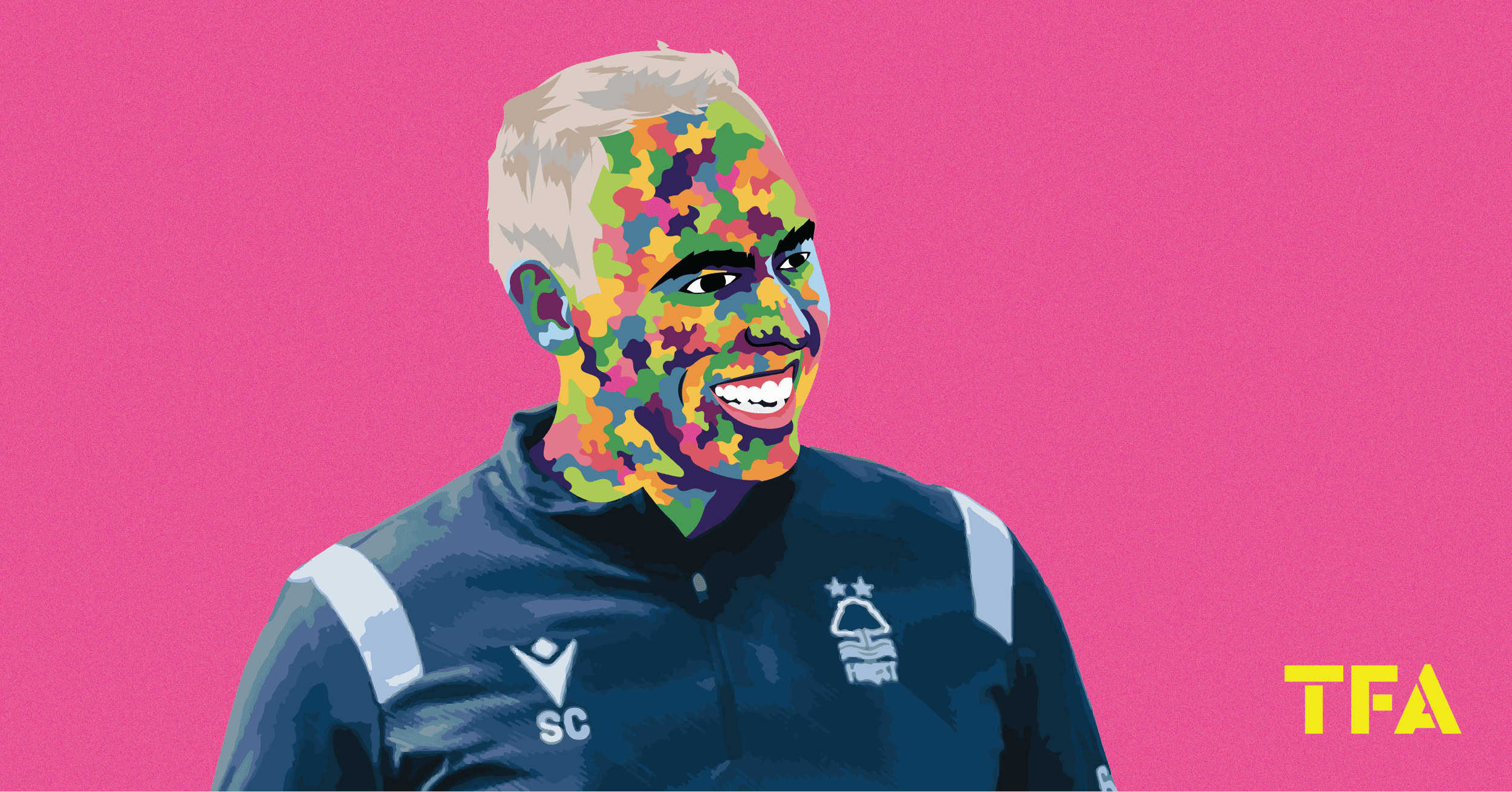



Comments